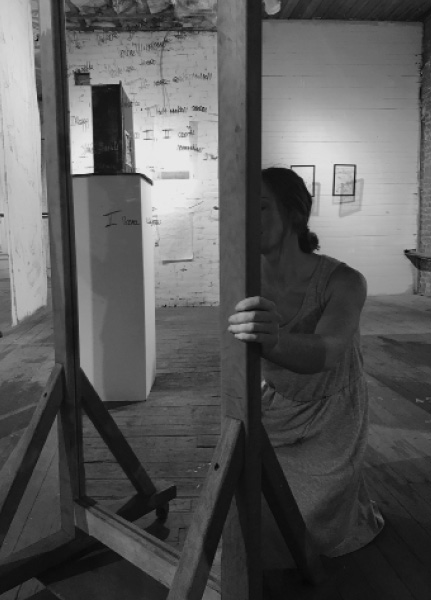
THE MIRROR
first performed on August 4, 2017
The Merchant Room, Fort Collins, CO
performed once in 2017
ALEXANDRA LAKE
Brooklyn, NY
656648579a656648579l656648579e656648579x656648579a656648579n656648579d656648579r656648579a656648579l656648579l656648579a656648579k656648579e656648579@656648579g656648579m656648579a656648579i656648579l656648579.656648579c656648579o656648579m
alexandrallake.com
THE MIRROR
ALEXANDRA LAKE
“The Mirror” revealed and navigated internal vulnerability in human relationships by experimenting with a visual representation of space between the person and the collective. For two hours on the opening night of an exhibition, I navigated the gallery space, moving around event attendees, and using the reflection of a two-sided mirror on casters to guide my movements, observe people, and to record words that I collected by eavesdropping on surrounding discourse.
The mirror worked as a window to observe the people around me. I had my back turned to the observed so that making eye contact referenced the experience of finding oneself watched through a window. This voyeurism became deeply personal through reflection. I used the mirror as a metaphor for where our relationship with ourselves lives. The standing mirror inhabits a role of self-evaluation. It occupies bedrooms, changing rooms, and figure-drawing studios. Observation through a mirror exposes a world of individual familiarity and produces a tension of exposure.
Using reflection to navigate my surroundings had an interesting effect on my relationship with my own image. In order to move and observe, I forgot about my reflection. I found myself treating it as a blindspot. The mirror space provided an escape from personal self-consciousness and the effect of being so close to my own reflection while acting as a perceived barrier to the observed audience. This forced a farsightedness and disconnection that provided me with feelings of disinhibition.
To create an additional sense of surveillance and to compound the visual observation with an auditory element, I was eavesdropping to collect words and record them on the glass. I was a filter, visualizing the linguistic space as if words could be caught floating on the surface of the mirror. I used myself as an authority to take away the control of language and re-present it. I erased and combined speech, with no compositional directive, in order for it to emulate the continual transformation of verbal associations between people.
As a means of possible escape for the audience, the mirror provided a parallel reflection in which I was not operating on the reverse side. People could consider the display of language and view their reflection without feeling watched. While providing an avoidance of my gaze, people confronted their own words and were in the epicenter of my auditory surveillance. This fluctuating relationship between the audience and myself explored boundaries of privacy and exposure.